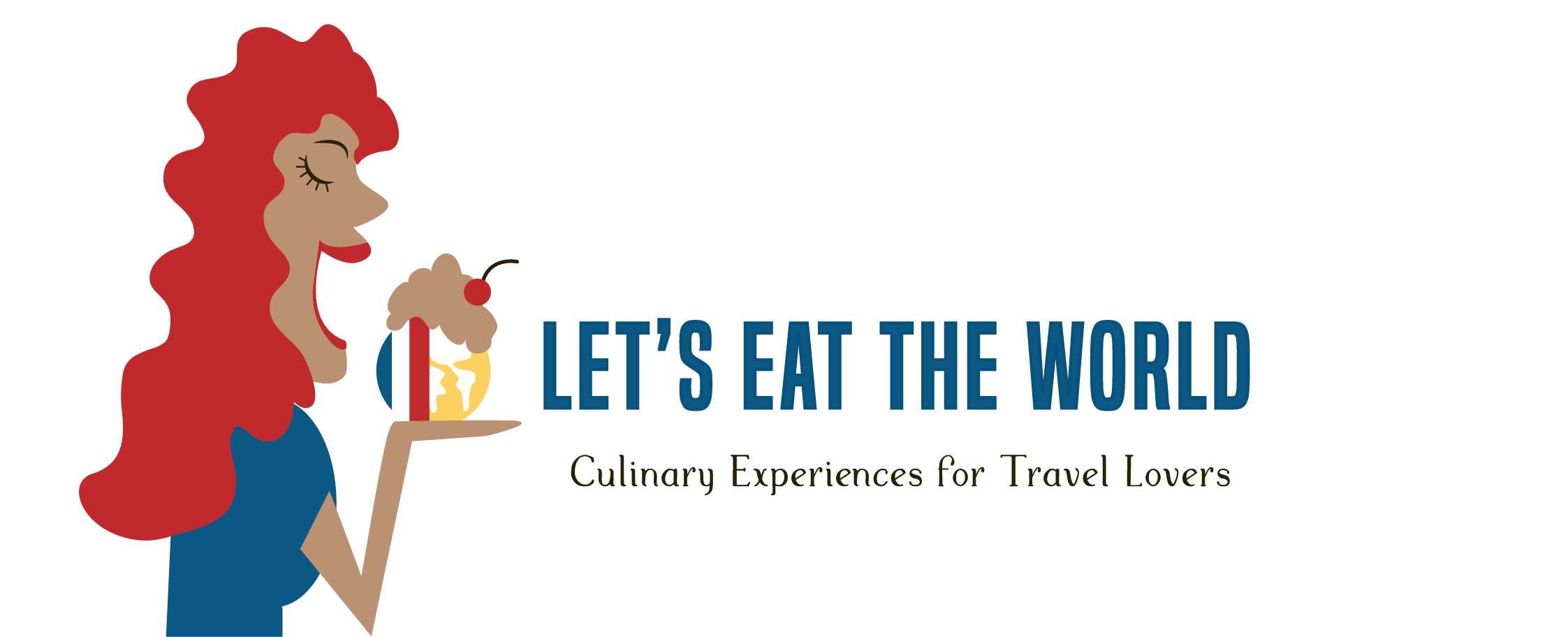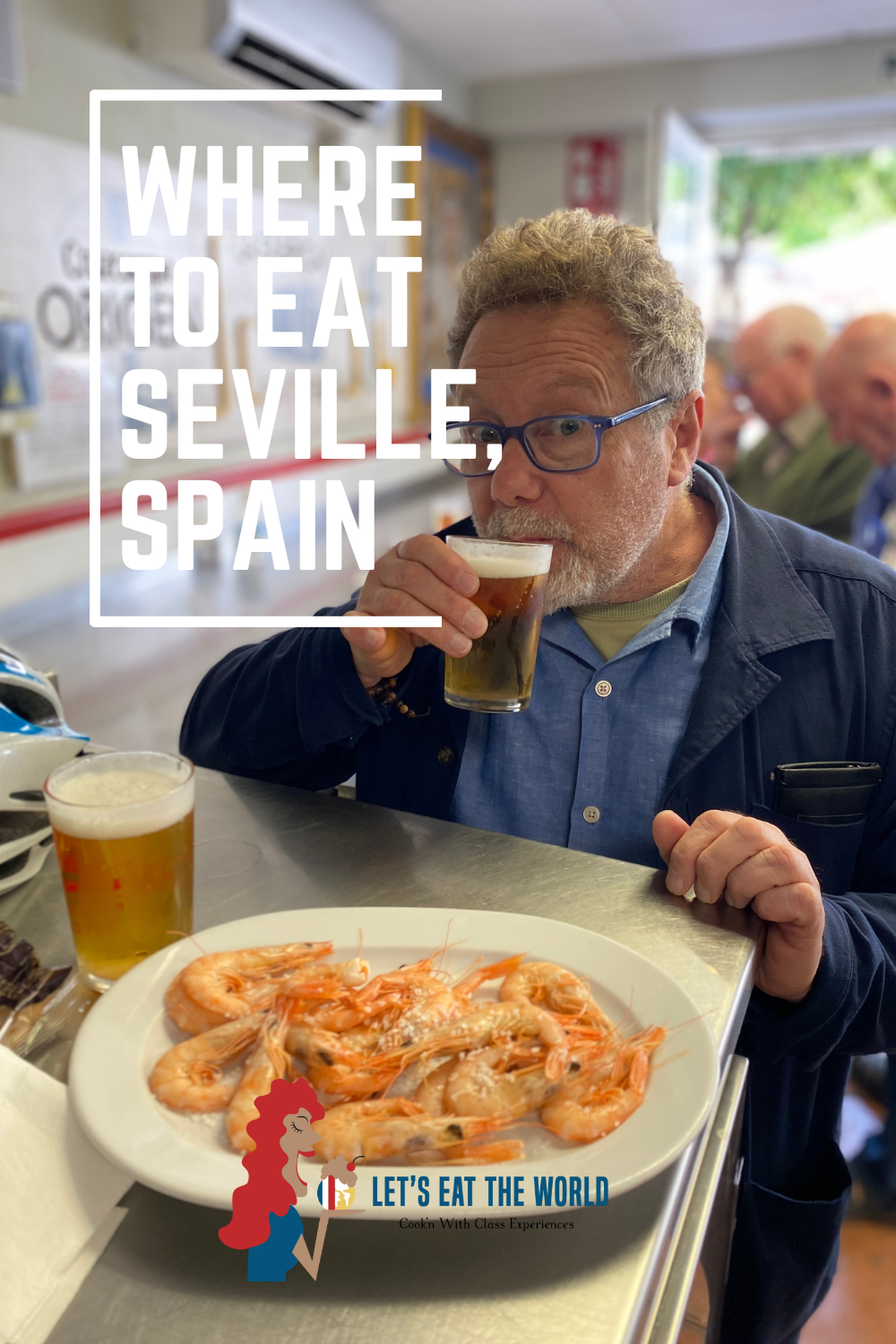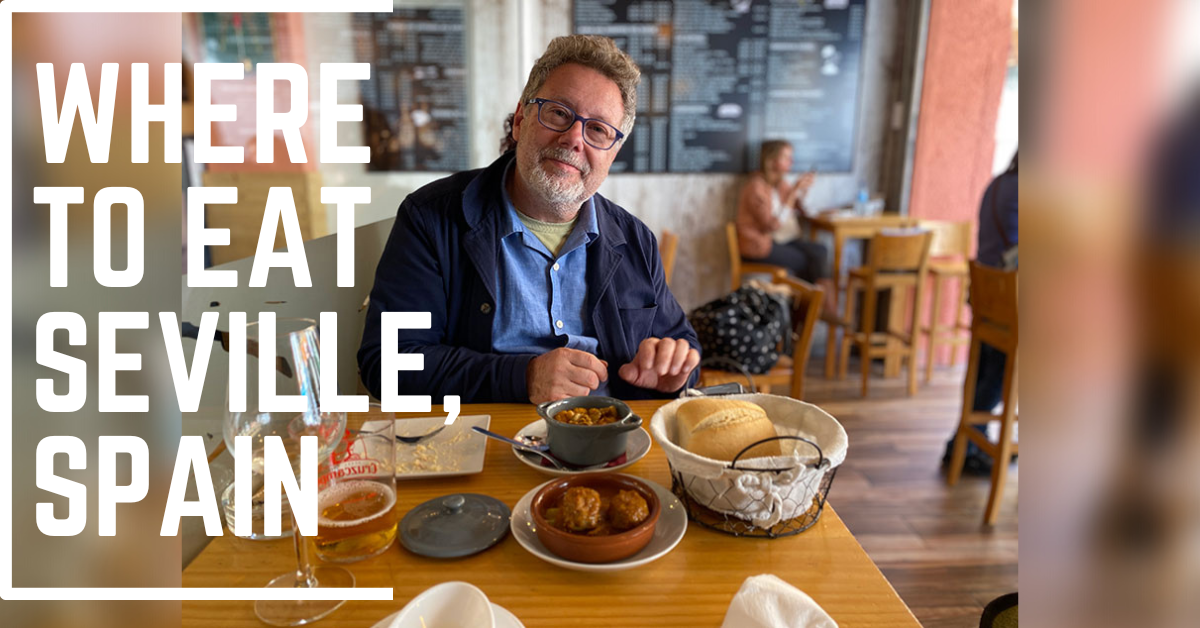
Where to Eat in Seville. What to See in Seville – Plan the perfect visit
Have you ever been to Seville, Spain? After reading this, you may have a better understanding of what drew us here and why this is a perfect place for a Food & Wine Lovers cultural holiday in Seville, Spain. What I’m about to share with you below is only the tip of the iceberg and we could go on and on about this beautiful city in whose presence you can delight in a guided cultural & culinary adventure. We would gladly be your hosts on this journey of discovery.

I’m going to answer your question about what to see and where to eat in Seville to help you plan that perfect vacation in Seville, Spain but first allow me to tell you a bit about this magnificent & vibrant city. It’s a place you may visit several times or like many, decide to relocate to. Okay, so maybe you want to avoid the summer months when the heat can be difficult for many including the Sevillanos.
Perhaps you’ll come for the have-to-see-it-at-least-once Semana Santa (Holy Week leading up to Easter), or join into the festive week of the Feria de Abril! Or you come and mingle with the locals when it’s freezing where you live and quite lovely in Seville. Whatever brings you to Seville, you’ll want some expert tips to get you started and I’m here to help.
Location
Seville is the capital and largest city of Andalusia and the province of Seville – so if you live in the center of Seville, your address could be Seville, Seville, kind of like New York, New York. It is situated on the lower reaches of the Guadalquivir River, in the southwest of the Iberian Peninsula. Seville is located about 80 kilometers (50 miles) from the Atlantic Ocean, and 120 kilometers (70 miles) from the Mediterranean sea It is the only river port in Spain.
The city of Seville was founded as the Roman city of Hispalis. Known as Ishbiliyah after the Islamic conquest in 711, Seville became the center of the independent Taifa (Muslim principalities and kingdoms of the Iberian Peninsula (modern Portugal and Spain), of Seville following the collapse of the Caliphate of Córdoba in the early 11th century; later it was ruled by Almoravids and Almohads until being incorporated into the Crown of Castile in 1248.
Owing to its role as a gateway for the Spanish Empire’s transatlantic trade, Seville became one of the largest cities in Western Europe in the 16th century. Coinciding with the Baroque period, the 17th century in Seville represented the most brilliant flowering of the city’s culture; then began a gradual economic and demographic decline as silting in the Guadalquivir forced the trade monopoly to relocate to the nearby port of Cádiz. Thank you, Wikipedia!
What to see, What to do
Seville is approximately 2,200 years old. Various inhabitants of this marvelous city shaped her majestic face, and her personality, and account for a large well-preserved historical center.
The Cathedral & La Giralda

There are many, many things to visit, of course. A large choice of medieval churches, some palaces, Arabic-influenced architectural monuments, modern buildings, and outstanding parks but if you somehow forget to take a look at the absolutely astonishing Cathedral and its breathtaking tower, La Giralda, (literally breathtaking if you go up, which of course you should), you will have missed such a big part of the city.
Metropol Parasol – Las Setas
Everyone calls it Las Setas but its official name is Metropol Parasol – A kind of huge and impressive “mushroom” (setas) umbrella, made of white wood. Not only is this Europe’s largest wooden structure, but it is also a really beautiful building. It was not (much like the Eiffel Tower), to all the inhabitants of Seville’s liking but honestly, what would Seville be without it? Visit the terrace where people take pictures while people skate around. Under la Setas, you will find the Mercado de la Encarnacion and the Antiquarium and archaeological museum.
Plaza de España
If you are one of those people who travels the globe looking for movie filming sites, you may have hit the motherload here. Welcome to the Plaza de España or Naboo if you like. As seen in cinema from Star Wars to Game of Thrones this is one amazing place. It houses government offices and is decorated with ceramics that retell the history of Spain and of each province. Don’t miss it, only the outside can be seen but it is in every guidebook and countless Instagram posts, but you can also stroll through the galleries and staircases. I recommend an early Sunday morning for this. We enjoyed an amazing family photo shoot with the wonder Ludivine Mimar on the Plaza de España and now I have a hard time selecting the most beautiful of the many beautiful photos she took!
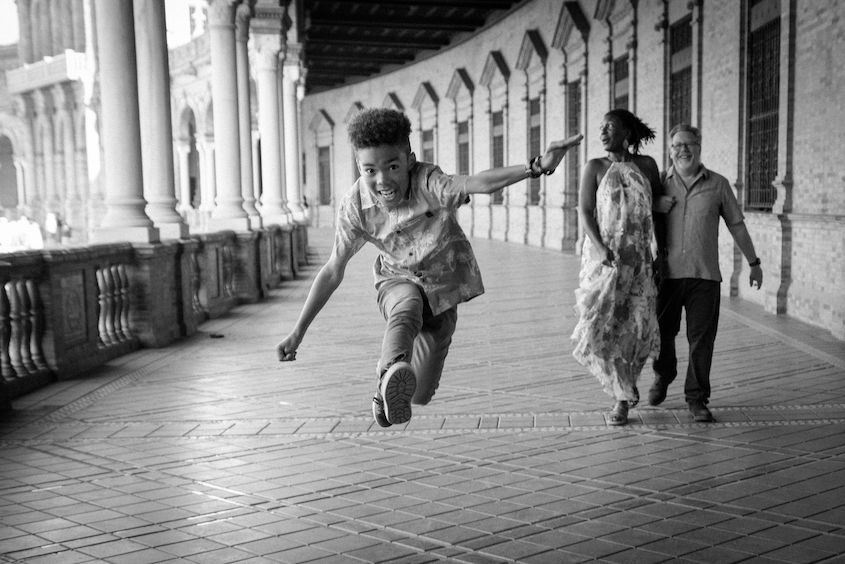
Photo by Ludivine Mimar
Parque Maria Luisa
Next to Plaza de España, where the locals like to go for a stroll, you have the Maria Luisa Park, with the classic ducks, birds, trees, water…. peace, and fresh air when the heat is strong and you get tired of the town crazy activity. Take a horse carriage to go around, it is worth it. Please don’t feed the ducks! Even if you see the locals do it. Thank you!
Barrio Santa Cruz (The Santa Cruz neighborhood)
The city’s tourist heart, Santa Cruz is the perfect place to walk around the old Jewish quarter’s narrow streets. The famous orange-tree-lined streets are full of shops selling souvenirs, handicrafts, and ceramics. Also, some churches sell homemade pastries and of course, there are lots of small tapas bars.
Réal Alcazar The Royal Alcazar
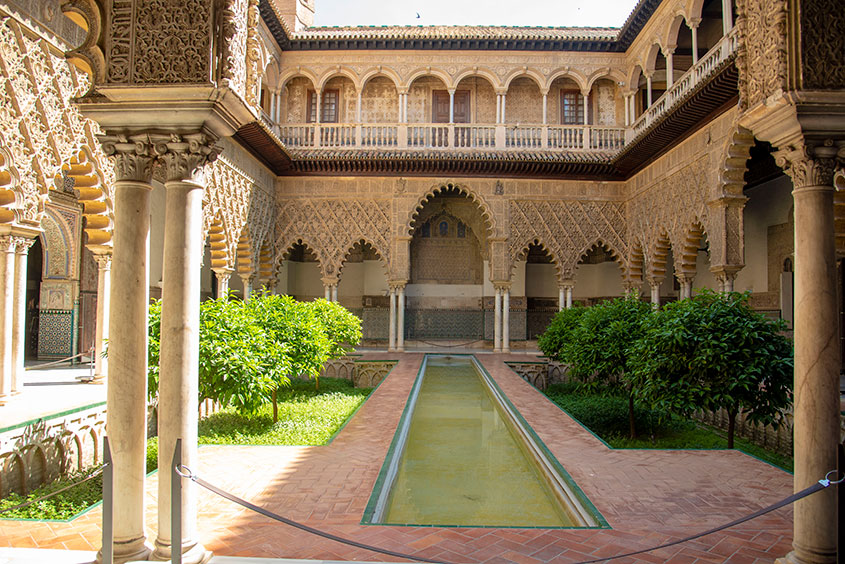
If you have time for only one monument to visit, visit this one. The Alcazar takes a special place during our culinary tour in Seville with a private guided tour tracing the history and architecture of this royal palace which is still in use today by Spain’s royals. You can even visit their royal chambers.
It is a palace that took 500 years to build in total. It went through a lot as you can imagine, but has a unique architectural identity, with its Catholic symbols and Arabic-inspired Architecture, built in respect of both communities, Arabic and catholic, the place is marvelous and glamourous, romantic, & peaceful. The tiles are an important part of Seville’s history and here there are beautiful. Take time to rest in the garden and look for the peacocks.
Where & how to eat
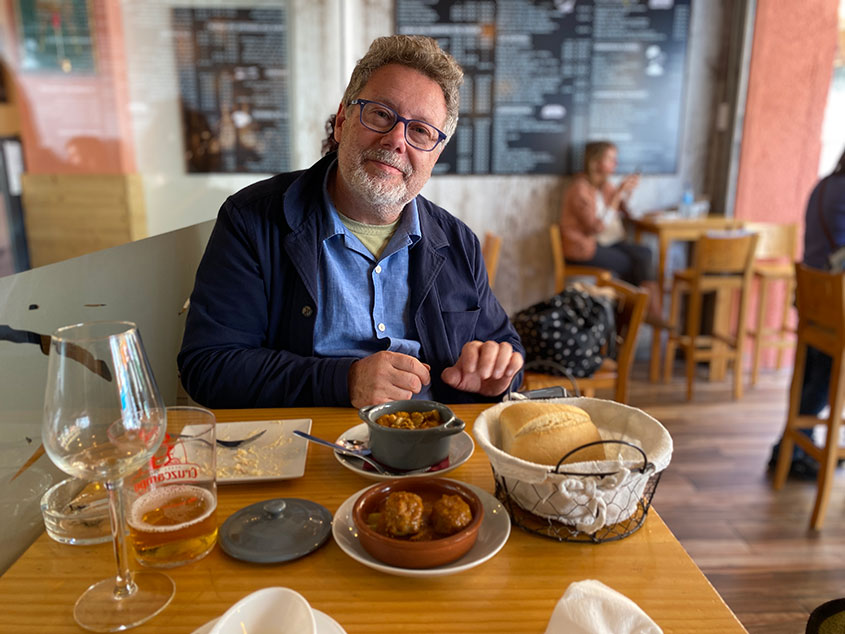
Restaurants are everywhere in Seville, and locals and tourists share the same love of food and conviviality. Terrace, beer, and small plates of food are the norm. Sevillans eat outside all the time and restaurants open around 1 pm the Sevillans eat between 1h30 and 3 pm, or even later on weekend. In the evening restaurants open around 8h30 so get a merienda in the afternoon with a café con leche and in the morning do not miss the traditional snack around 10h30/11 and order a cafe con leche and a ”media de jamon can aceite” it is a small sandwich that keeps you capable of waiting for the real meal.
With these simple things in mind, you’ll be a Seville dining expert – or close enough:
- Over the weekend you better reserve where it is possible, as the locals meet friends and family for meals and it gets busy. Sometimes you can get lucky, and if you arrive right at the opening, maybe they will take pity on you and give you a table. Don’t be surprised to see lots of empty tables all with reservado on them but no people actually turning up during your entire meal.
- I won’t divulge all my restaurant secrets (you’ll have to come to visit me for those) but I’m going to give you a few options to consider when visiting.
- In Seville (and probably much of Spain), you are meant to start with a drink order, so don’t start rattling off the food you want to eat.
- Always order a little at first, don’t order your entire meal at once, and begin with 2 or 3 tapas to share, You can always order more later, or go somewhere else for something different.
- You can share just about any dish on the menu, in just about any restaurant from the simple tapas bar to a high-end establishment – there is no shame.
Restaurants worth trying:
La Bodega Santa Cruz
Not far from the Cathedral, La Bodega Santa Cruz is the perfect place to stand outside with a beer – and stand you most likely will! It is self-service so you go to the counter, you fight to get a spot and to get attention from the waiter, place your order, take it with you to your standing (or sitting if you’re lucky) table, and you share. All tapas are pretty good, not spectacular but not expensive & the atmosphere is fun, busy & crazy… You are part of the Seville life when there. Tourists come here but I would not call this place touristy.
Bodega Dos de Mayo
For the Octopus and the fried fish, and also the great terraza. you can eat inside but we like to dine outside in this small quiet square where street performers occasionally play.
The food is always good and the service is excellent. No reservations on the weekends so come early to score a spot before the Sevillanas arrive. One particularity – if you like to have coffee at the end of your meal, you won’t be having it here! Check out their menu.
On la plaza de la Alamada, where if you are trendy, young, and hip or would like to imagine that you once were, you will find plenty of late-night “crazy” but you’ll also come across a few good restaurants.
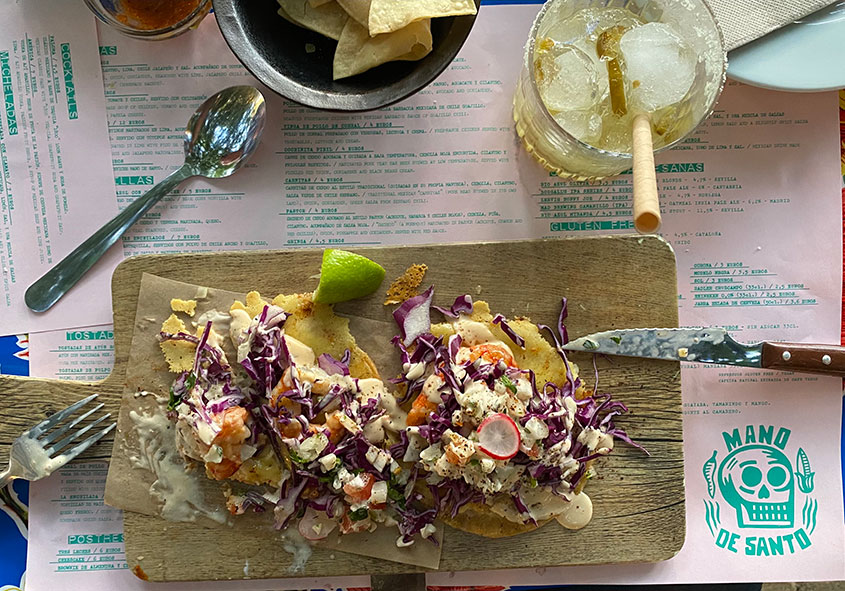
If you are craving Mexican food (which happens to me at least once a week ) Mano de Santo tacos are good and authentic, a bit on the expensive side for cocktails but it is a good place to be and you can tell that people love this place because it is always packed. Mano de Santo is starting to offer outposts in various spots in the city.
Another Taco option is the competition, Taqueria La Lupe which took on a second locale after their first on Calle Feria to also be on the Alameda. They have an extensive vegetarian and vegan selection.
El Disparate
When you can’t live by tapas alone. El Disparate which is the kid brother to another Sevillian restaurant we’ve enjoyed is a bit more “formal” than some of the other Alameda selections but without any pretension at all. While it is not a tapas place, like everywhere in Seville, you can share a plate with no problem.
I like the food that is made here because it is tasty and real. One of the best restaurants in Seville, and it is affordable. Try the Ajo Blanco if offered that day – a cold soup made of raw almonds and a touch of garlic… really simple and really amazing.
Other great food options
El Cairo
El Cairo is located in the Arenal district. For the Croquetas de Gambas, the best in town, and a plate of Jamon (Iberico ham is expensive pretty much everywhere but sooo good). Try also the cola de toro as a tapas or media (half portion), it is an oxtail stew that is very common here in Seville, and it is the specialty of the house)
De la O
Located in Triana View on the river (well a view of the river behind the trees at any rate), very good modern tapas, a more fancy restaurant, more expensive of course, but frankly worth going to for an afternoon or evening away from the crowded city. De la O is a wonderful restaurant that you will be sure to enjoy.
Mercado de Triana
There is a reason people tell you you MUST go here. You have to experience it. Yes, it is touristy but it is also just as local. The heartbeat of Triana. You can sample, try out a few of the restaurants, and if you would like to bring home some jamon, cheese, and or spices, a visit to the Triana market is a must.
For a Paella
Paella is found throughout Spain and yes, Valencia is where you’ll find some of the best paellas in the country but good paella can be founding Seville as well. There are a lot of choices but not all paella was created equal. I suggest you visit the Mercado de Triana and have paella at Arroceria Criaito inside. The rice is perfectly made and they ask the entire table to take the same paella as they do it to order, as it should be… Delicious. You need to order your paella ahead of time.
Fun Facts About Seville
- NO8DO is the official motto of Seville, popularly believed to be a rebus signifying in Spanish No me ha dejado, meaning “She [Seville] has not abandoned me”. The phrase, pronounced with synalepha as [no ma ðeˈxaðo] no-madeja-do, is written with an eight in the middle representing the word madeja. This motto, I’ve been told is to remind everyone that Seville stood by its king Don Alfonso X against his ambitious son who wished to dethrone papá!
- Seville hosted the World Fair twice. Once in 1929 as part of the Iberico-American Exhibition of which both the Plaza de España and the Maria Luisa Park are some results and then in 1992 World Expo. On the island of La Cartuja, you can see some of the pavilions from the ’92 Expo. The organization of such events changed the city tremendously, starting with the river Guadalquivir. The river was completely removed from its nest to a new place 350 meters away, new bridges were built and the city keeps talking about it all the time. Unfortunately, some of the features, like an air train made for the occasion are not running anymore. 5 years of work to get to the Sevillan expo 92 was so important for bringing the world to Seville. To see pictures from the ’92 Expo, click here.
If you are interested in the immense construction project that took place for this expo you should have a look at this video (In Spanish).
Now doesn’t all this make you want to visit Seville?!
Come join us for a Food & Wine Lover’s Tour in Seville. We are now offering private food tours as well as culinary holidays in the beautiful Andalusian capital.
Food & Wine Lovers Tours in Seville (accommodations included):
For more information and to reserve be sure to have a look at culinary tours in Seville.
And if you are interested in having us organize a private food tour for you, please contact us
